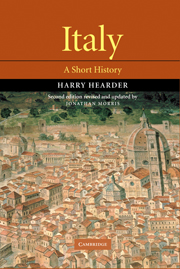Book contents
- Frontmatter
- Contents
- List of illustrations
- Preface
- 1 Italy in the classical world
- 2 The early Middle Ages
- 3 The high Middle Ages
- 4 The Renaissance
- 5 The political and cultural eclipse of Italy
- 6 The Risorgimento, 1790–1861
- 7 From Unification to Fascism, 1861–1922
- 8 The Fascist disaster, 1922–45
- 9 Italy since the Second World War, 1945–80
- Epilogue: From the First to the Second Republic: Italy 1980–2001
- A brief guide to further reading
- Index
1 - Italy in the classical world
Published online by Cambridge University Press: 05 February 2015
- Frontmatter
- Contents
- List of illustrations
- Preface
- 1 Italy in the classical world
- 2 The early Middle Ages
- 3 The high Middle Ages
- 4 The Renaissance
- 5 The political and cultural eclipse of Italy
- 6 The Risorgimento, 1790–1861
- 7 From Unification to Fascism, 1861–1922
- 8 The Fascist disaster, 1922–45
- 9 Italy since the Second World War, 1945–80
- Epilogue: From the First to the Second Republic: Italy 1980–2001
- A brief guide to further reading
- Index
Summary
Prehistoric Italy
No other country in Europe can claim the continuity of civilization achieved in Italy. Greece had her moment of cultural and intellectual brilliance, but the history of Italy has shown a sustained development, falling occasionally into comparative backwardness, but always returning to peaks of civilized excellence. It is this sense of continuity that most strikes the foreigner, an impression that people have for long ages lived, worked and built in this narrow peninsula.
There has, in truth, been continuous human life since the Ice Age. An early species of man, homo erectus, was in Italy some half a million years ago, and our own species, homo sapiens, was present some quarter of a million years ago. Palaeolithic, or Old Stone Age, man lived in Italy in the last stage of the Ice Age, a stage more severe than earlier ones. The temperature of Italy at that time is thought to have been about nine degrees centigrade colder, in winter and in summer, than it is today. In winter there was snow over most of Italy for many months. The country was radically different in another sense. As the oceans had frozen, the Mediterranean had partly dried up. The seas of the world were at least 130 metres lower than they are now, which meant that Italy was an appreciably larger country, with the coastline being twenty or thirty kilometres farther out than it is now.
- Type
- Chapter
- Information
- ItalyA Short History, pp. 1 - 37Publisher: Cambridge University PressPrint publication year: 2001



